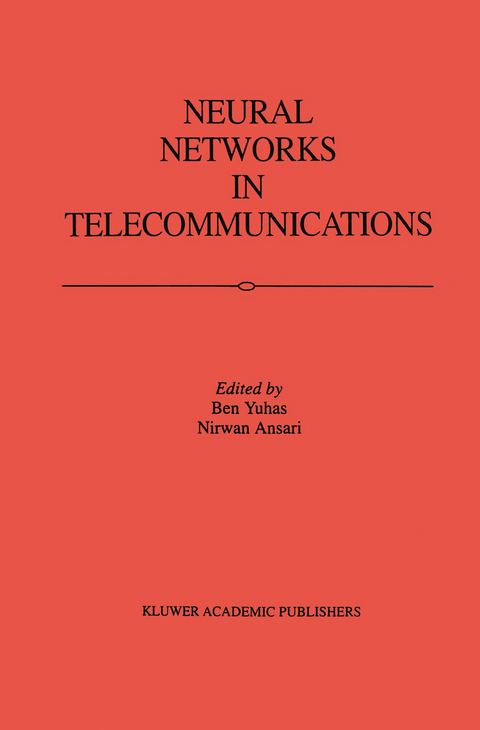
Neural Networks in Telecommunications
Springer (Verlag)
978-0-7923-9417-4 (ISBN)
Neural networks offer the computational power of nonlinear techniques, while providing a natural path to efficient massively-parallel hardware implementations. In addition, the ability of neural networks to learn allows them to be used on problems where straightforward heuristic or rule-based solutions do not exist. Together these capabilities mean that neural networks offer unique solutions to problems in telecommunications.
For engineers and managers in telecommunications, Neural Networks in Telecommunications provides a single point of access to the work being done by leading researchers in this field, and furnishes an in-depth description of neural network applications.
1 Introduction.- 1 What is a Neural Network?.- 2 Computing with Neural Networks.- 3 Building the Correct Neural Network.- 4 When are Neural Networks Appropriate?.- 2 Neural Networks for Switching.- 1 Introduction.- 2 Switching.- 3 Neural Circuit Design.- 4 Neural Approaches to Switching.- 5 Conclusion.- 3 Routing in Random Multistage Interconnection Networks.- 1 Introduction.- 2 The Communication System.- 3 Exhaustive Search and Greedy Routing.- 4 The Neural Network Router.- 5 Performance Measures for Routers.- 6 Simulation Results.- 7 Analysis.- 8 Conclusions and Future Work.- 4 ATM Traffic Control Using Neural Networks.- 1 Introduction.- 2 ATM Traffic Control.- 3 Neural Network Applications in the ATM Network.- 4 Adaptive Call Admission Control.- 5 Adaptive Link Capacity Control.- 6 Further Research Directions.- 5 Learning from Rare Events: Dynamic Cell Scheduling for ATM Networks.- 1 Introduction.- 2 ATM Networking.- 3 On-Line Dynamic Programming.- 4 Experimental Evaluation.- 5 Simulations.- 6 Conclusions.- 6 A Neural Model for Adaptive Congestion Control in ATM Networks.- 1 Introduction.- 2 Problem Formulation.- 3 Adaptive Learning Rate Algorithm.- 4 Neural Network Control Scheme.- 5 Simulation Results.- 6 Summary.- 7 Structure and Performance of Neural Nets in Broadband System Admission Control.- 1 Introduction.- 2 Neural Networks for Connection Admission Control.- 3 Example of a Neural Network for Admission Control.- 4 Conclusions.- 8 Neural Network Channel Equalization.- 1 Introduction.- 2 A Brief Introduction to Digital Transmission Theory.- 3 Signal Detection and Estimation.- 4 Two Dimensional Signalling and Complex Neural Networks.- 5 Summary.- 9 Neural Networks as Excisers for Spread Spectrum Communication Systems.- 1 Introduction.- 2 Time Domain Processing.-3 Conclusions.- 10 Static and Dynamic Channel Assignment Using Simulated Annealing.- 1 Problem Description.- 2 Existing Approaches.- 3 Applying Simulated Annealing to the Static CAP.- 4 Simulated Annealing in a Running System.- 5 Conclusions.- 11 Cellular Mobile Communication Design Using Self-Organizing Feature Maps.- 1 Introduction.- 2 Mobile Network Planning.- 3 Traffic Density Determination using a Self-organizing Feature Map.- 4 The Main Algorithm.- 5 Experimental Results.- 6 Conclusions.- 12 Automatic Language Identification Using Telephone Speech.- 1 Introduction.- 2 Background.- 3 A Telephone Speech Corpus For Automatic Language Identification.- 4 Human Listening Experiments.- 5 A Segmental Approach to Automatic Language Identification.- 6 Summary and Future Work.- 13 Text-Independent Talker Verification Using Cohort Normalized Scores.- 1 Introduction.- 2 Talker Identification Background.- 3 Related Work.- 4 Cohort Normalization.- 5 STIMIT.- 6 Talker Identification System.- 7 Vector Quantization.- 8 Experiments on 90 Talkers.- 9 Experiments on All 630 Talkers.- 10 Multilayer Perceptron.- 11 Fixed Versus Variable Training Sentences.- 12 Preliminary Experiment on Real Telephone Speech.- 13 Discussion.- 14 Conclusion.- 14 Neural Network Applications in Character Recognition and Document Analysis.- 1 Introduction.- 2 The Character Recognition Process.- 3 The Basic Recognizer: LeNet.- 4 Segmentation.- 5 Normalization.- 6 Finding the Region of Interest.- 7 Additional Applications.- 8 Conclusions.- 15 Image Vector Quantization by Neural Networks.- 1 Introduction.- 2 Neural Networks for Vector Quantization.- 3 Neural Networks for Adaptive Vector Quantization.- 4 Conclusions.- 16 Managing the Infoglut: Information Filtering Using Neural Networks.- 1 Introduction.- 2 Previous work on filtering.- 3 Neural Networks for Filtering.- 4 Reinforcement learning — AIR.- 5 An Unsupervised Classifier — ART.- 6 Experimental determination of filter validity.- 7 Future Directions.- 17 Empirical Comparisons of Neural Networks and Statistical Methods for Classification and Regression.- 1 Introduction.- 2 Two Problems.- 3 Regression and Classification Methodologies.- 4 Results on Regression for Switch Memory.- 5 Results on Classification of DSO-Rate Traffic.- 6 Discussion.- 18 A Neurocomputing Approach to Optimizing the Performance of a Satellite Communication Network.- 1 Satellite Communications.- 2 The Self-organization Method.- 3 The Cost Minimization Method.- 4 Discussion.
| Erscheint lt. Verlag | 31.12.1993 |
|---|---|
| Zusatzinfo | XIV, 369 p. |
| Verlagsort | Dordrecht |
| Sprache | englisch |
| Maße | 155 x 235 mm |
| Themenwelt | Informatik ► Theorie / Studium ► Künstliche Intelligenz / Robotik |
| Naturwissenschaften ► Physik / Astronomie ► Astronomie / Astrophysik | |
| Naturwissenschaften ► Physik / Astronomie ► Theoretische Physik | |
| ISBN-10 | 0-7923-9417-8 / 0792394178 |
| ISBN-13 | 978-0-7923-9417-4 / 9780792394174 |
| Zustand | Neuware |
| Haben Sie eine Frage zum Produkt? |
aus dem Bereich


